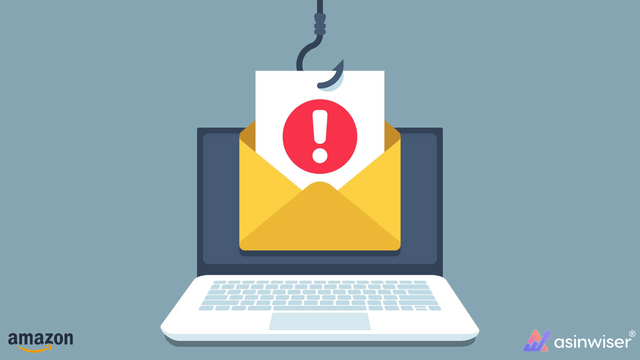
What is Amazon phishing and how can Csellers protect themselves from it?
What is Amazon phishing and how can Csellers protect themselves from it?
From time to time you would possibly receive emails that appear as if they are available from Amazon Pay, but they’re falsified. These emails might direct you to an internet site that appears the same as the Amazon Pay website. You would possibly even be asked to supply account information like your email address and password combination.
These false websites can steal your sensitive login or payment information, which is nothing but fraud and is known as Amazon phishing. Some phishing messages contain potential viruses or malware that may detect passwords or sensitive data. Amazon phishing has become a huge problem for sellers and impacts the customer-seller relationship.
In this article, we’re going to discuss what is Amazon phishing and how can sellers protect themselves from it.
What is Amazon phishing?
Phishing is a term given to cybercrime. Phishing Amazon has caused various new phishing campaigns by sending Amazon phishing emails where users are asked to click on the link which redirects them to a similar website as Amazon. Amazon phishing email is an email sent by a person or company to gather personal information and which is falling people’s prey to scams.
This amazon phising email uses Amazon’s logo and the email’s content and body are similar to the official Amazon. Phishing email to Amazon for sellers is mostly about the issues related to the seller’s central account being at risk due to which the product list can be affected. We recommend that you just install a computer programme and keep it updated from time to time.
Explore Asinwiser, an intelligent Amazon software tool for you, to build your career as an Amazon reseller. Click here to find more information.
Here are some key points associated with fraudulent emails:
● Know what Amazon Pay won’t ask you to produce in an email.
● Amazon Pay might sometimes have to ask you for important information, but you’ll always be directed to produce this information through the Amazon Pay website.
● You should not provide personal information just like the following in an email:
1. Your full or partial Social Security number or tax number
2. Your date of birth
3. Your MasterCard number, PIN, or MasterCard security code (including “updates” to any of the above)
● Be wary of attachments in suspicious emails
● We recommend that you just don’t open any email attachments from suspicious or unknown sources.
Email attachments can contain viruses that may infect your computer when the attachment is opened or accessed. If you receive a suspicious email purportedly sent from Amazon Pay which email contains an attachment, we recommend that you just delete the e-mail — don’t open the attachment.
● Look for grammatical or typographical errors
Look for poor grammar or typo grammatical errors because oftentimes phishing emails on amazon are translated from different languages.
● Check the website address:
Genuine Amazon Pay websites are always hosted on one among the subsequent domains:
● Authorize.payments.amazon.com
Sometimes the link included in spoofed emails feels like an authentic Amazon Pay address. You’ll be able to check where it points by pointing to the link; the particular website to which it points is going to be shown within the status bar at the underside of your browser window or as a pop-up.
● Protect your account information
If you probably did click through from an amazon spoofing email and you entered your Amazon account information, you must immediately update your Amazon website password.
Here’s how:
● Go to the Amazon website and click Your Account.
● On the following page, click the Login & security link.
● On the Login & security page, click the Password Edit button, update your password, and click Save changes.
● If you submitted your MasterCard number to the positioning linked to the solid email message, we advise that you just take steps to guard your information.
● You would possibly want to contact your MasterCard company, for instance, to notify them of this matter.
● Delete that MasterCard from your Amazon account to forestall anyone from improperly regaining access to your account.
If you are an online Amazon seller, then you must have an intelligent tool that will guide your business towards success by targeting the brand story, right keyword, products research, analyzing competitors, fba calculator, fba fee calculator, repricer and so much more. Get your ticket to success today!
How can Amazon sellers protect themselves from phishing?
Below are a few factors to consider for protecting sellers from phishing:
● When you receive any email regarding the changes or verification of the information in your seller central account. Then you must directly visit Seller Central.
● Don’t forget to check the links and URLs given in the email.
● Make sure you have set up a 2-factor verification process to log in just to be on the safer side.
● The phishing email from amazon with an ‘Unsubscribe’ button and when you click on a button and it redirects to your valid email address which can target.
● If you are someone who checks the spam folder and finds something important from Amazon, it might be a phishing email. Hence, we suggest you refrain from doing it if you don’t want to be another prey of phishing emails on amazon.
● Avoid using generic passwords including your name, parents’ names, birthdates, place of birth and many more.
● Don’t forget to disable the autofill and “remember me”.
● Use different passwords for different accounts.
● VPNs are high levels of encryption that work towards keeping you safe from Amazon phishing scams. However, you can turn on a VPN just to be safer side.
● Remember, Amazon never asks for personal information so when you check any suspicious emails or calls.
Where to send amazon phishing emails?
When you receive a phishing amazon email, kindly send an email to stop-spoofing@amazon.com.
While sending an amazon report phishing email, don’t forget to attach a phishing email so that tracking down the source of the phishing attack becomes easier.
When you report a phishing email to Amazon using your phone, then you need to report it by filling out a form and providing all the information and details so that suitable action is taken.
Wrapping it up
Amazon is a huge eCommerce platform and is quite prone to phishing email amazon and amazon stop spoofing. As sellers are outright vulnerable to such phishing email amazon attacks. As a result of this, we have listed a few ways to protect sellers from amazon phishing email which can be used and taken into consideration. We hope you follow the above-mentioned tips and look for signs to avoid getting into phishing.
An intelligent software tool—Asinwiser— is what you need as an Amazon. It is an impeccable solution for all your needs, including product research, competitor research, fba calculator, fba fee calculator, profitability calculator, and repricer.
- Tags: Amazon FBA
Share this:
Subscribe to Our Newsletter
Recent Post
- Top 13 Amazon Inventory Management Tools for FBA Sellers in 2023
- Asinwiser: The Ultimate OMSGuru Alternative for Amazon Sellers
- Repricer.com Alternative: Why Asinwiser is the Superior Choice for Amazon Sellers
- Aura Alternative: Why Asinwiser is the Superior Choice for Amazon Repricing
- Maximize Amazon Sales with Asinwiser: The Superior Amazon Repricer & Revenue Analytics Tool





